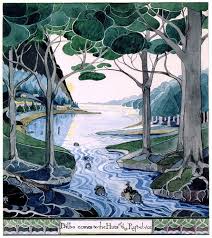a most beautiful house and estate in Lydney on the edge of the River Severn, just a few miles from Chepstow.
From Gloucester it is a most beautiful drive with the broad sweep of the Severn intermittently at your side.
Originally bought in 1719 by Benjamin Bathurst, son of the Cofferer to the Royal Household of Queen Anne.
In 1875 a new house was built in the centre of the deer park overlooking the Severn.
The current garden was developed in the 1950's by Viscount Bledisloe,there is a woodland garden running along a secluded valley, planted with magnolias, rhododendrons, azaleas and other flowering shrubs. There is a paved terrace above and formal gardens which are popular in the Spring, when the daffodils bloom.
The area has an early British Iron Age promontory fort–type hill fort, known as Lydney Camp, covering 4.5 acres. The Romans used the site, until the early 4th century, for the extraction of iron ore. Open-cast iron mines, or scowles, and tunnels still exist throughout the hill.
In the late 4th century, the Romans built a temple to Nodens, a Celtic divinity who is reflected by the later figures of Nuada and Nudd alias Lludd in Irish and Welsh mythology respectively. Lludd's name survives in the placename of Lydney. Several model dog images have been found there, indicating it was a healing shrine. The structure was a cross between a basilica and the usual Romano-British style temple. The walls of the sanctuary or cella were arched colonnades until a fault in the rock below caused the almost total collapse of the temple. It was rebuilt with solid walls to the cella. There was a fish-covered mosaic with an inscription that referred to 'Victorinus the Interpreter', probably an interpreter of dreams. The Roman temple was accompanied by a large courtyard pilgrims' hostel and elaborate bath suite or thermae.
There is a legend that after about 20 years of the Romans leaving, the local people forgot the Romans had settled there and began to believe the ruins were the home to dwarves, hobgoblins and little people. The site was excavated by Sir Mortimer Wheeler in the 1920s. The author of The Lord of the Rings novel, J. R. R. Tolkien, was part of the excavation team and he is said to have been influenced by such folk tales which he used to develop his stories of Middle-earth.
. 
Tom, whilst at college is studying Land Management & Gamekeeping, the Estate has a diverse selection of fauna & flora, it is situated within the Forest of Dean and is composed of both deciduous and evergreen trees. Predominant is oak, beech is also common, and sweet chestnut has grown here for many centuries. The forest is also home to Foxgloves and other wild flowers. Conifers include some Weymouth Pine dating from 1781, Norway spruce, douglas fir and larch. The deer are predominantly fallow deer and these have been present in the forest since the second world war currently numbering around 300 (there were no deer in the Dean from about 1855 when they were removed in accordance with an Act of Parliament. More recently a few roe deer and muntjac deer have arrived, spreading in from the East but in much smaller numbers.
fallow
roe
muntjac
The Forest is also home to wild boar; the exact number is currently unknown but exceeds a hundred. The boar were illegally re-introduced to the Forest in 2006. A population in the Ross-on-Wye area on the northern edge of the forest escaped from a wild boar farm around 1999 and are believed to be of pure Eastern European origin; in a second introduction, a domestic herd was dumped near Staunton in 2004, but these were not pure bred wild boar —attempts to locate the source of the illegal dumps have been unsuccessful. The boar can now be found in many parts of the Forest.
This is why Tom chose Lydney for his placement, to stalk wild boar, something more unusual.
Locally there are mixed feelings about the presence of boar. Problems have included the ploughing up of gardens and picnic areas, attacking dogs and panicking horses, road traffic accidents, and ripping open of rubbish bags. The local authority undertook a public consultation and have recommended to the Verderers that control to a lower level is necessary - this is currently being considered. Under its international obligations the UK government is obliged to consider the reintroduction of species made extinct through the activities of man, the wild boar included.
Quite often people that do not live in the countryside do not understand that it has to be managed, if animal numbers are not controlled environments can be devastated, species can become extinct, and as in the last very harsh winter animals can suffer horrible deaths by starving.
I spoke to Tom tonight, he has had a great day today and was just going back over the Severn Bridge after having delivered eggs.
Is this a proud Mum moment - oh yes!!




You`d better send Tom over here. There are wild boar (called sangliers here) on the marsh and they are ENORMOUS!!!! Everyone is terrified of them!
ReplyDeleteThat was a giggle, the google security word for that comment was " DUCOPIG" !!
ReplyDeleteoh you deserve your Proud Mum Moment.. wonderful choice of profession of your young man. Thanks for such a lovely story about Lydney. My best friend and my godson live in Worcestershire, I love that part of the UK and used to visit as often as possible. It has been several years now, and I long for a summer in Worcs.
ReplyDeleteBless him and bless you beautiful post and definitely a proud Mummy moment ;-)) dee x
ReplyDeletesounds like a fantastic opportunity...lucky boy!
ReplyDeleteWhat a beautiful and inspirational place to work. Your boy will surely have the time of his life working in such an environment.
ReplyDeleteMy boy has all this to come in a few weeks after the dreaded AS's.